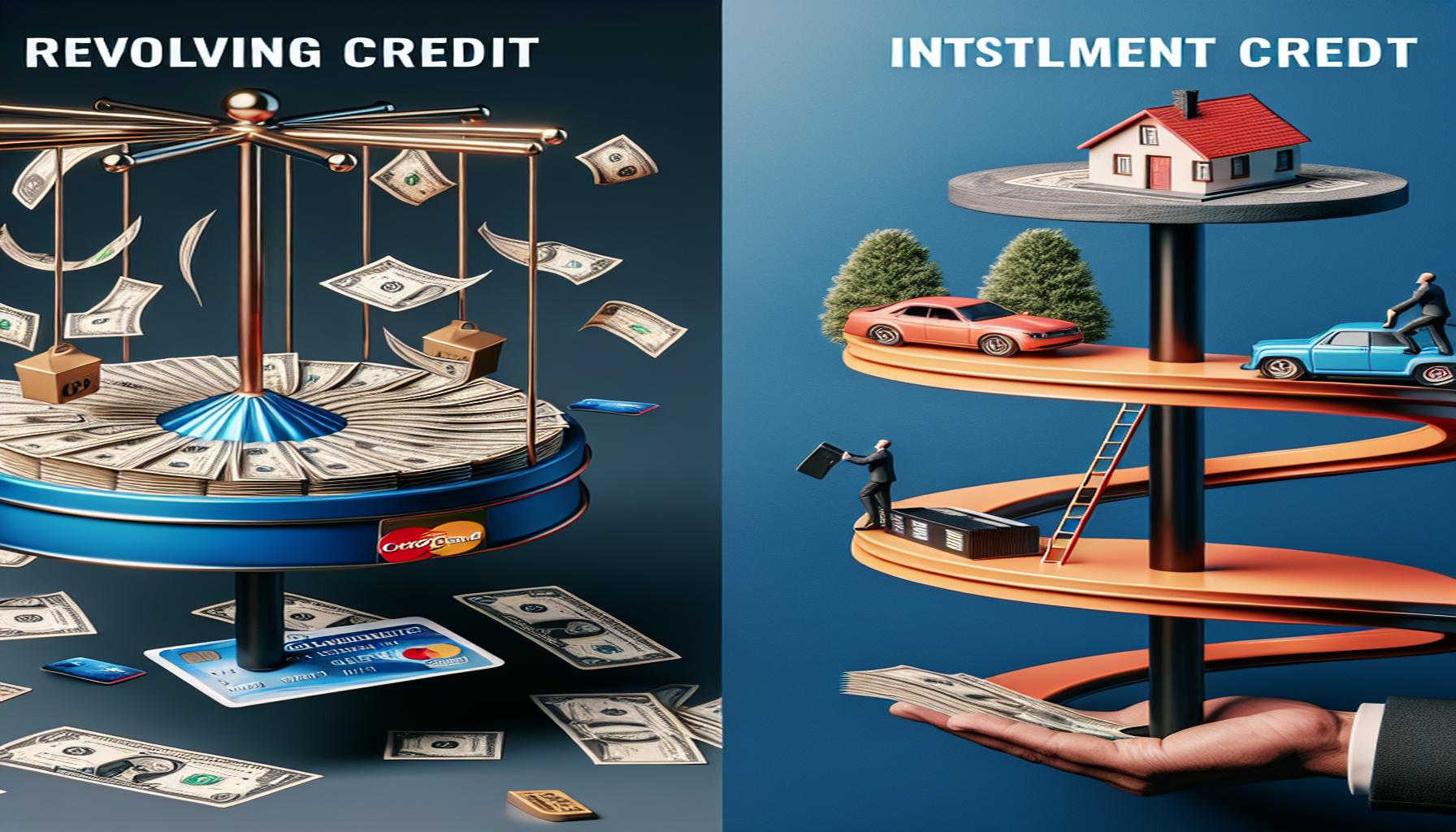Difference between revolving credit and installment credit

The Importance of Understanding Credit Types
When it comes to managing your finances effectively, grasping the different types of credit is crucial. Each credit category plays a unique role in financial decision-making and comes with distinct terms and implications. Among various types, two commonly encountered forms are revolving credit and installment credit.
What is Revolving Credit?
Revolving credit grants flexibility to borrowers, allowing them to access funds up to a predetermined limit and repay as needed. Credit cards are perhaps the most recognizable example of revolving credit. With a credit card, you can make purchases up to your credit limit; for instance, if you have a card with a $3,000 limit, you can spend anywhere from $0 to $3,000.
- One of the compelling features of this type of credit is the ability to borrow and repay multiple times without the need for a new application. This makes revolving credit an excellent option for regular expenses, emergency purchases, or when cash flow is tight.
- Additionally, your interest rate on revolving credit may fluctuate based on your spending and payment history. If you make on-time payments consistently, you may even qualify for lower rates and better terms over time.
Understanding Installment Credit
In comparison, installment credit involves borrowing a fixed amount of money that you agree to pay back over a specified term through regular payments. This format is commonly seen in personal loans, educational loans, and car loans. For example, if you take out a car loan for $20,000 with a repayment period of five years, you would make scheduled payments each month until the loan is fully paid off.
- Payments on installment loans are typically fixed, meaning you can budget easier because your monthly payment remains constant. This predictability can help you manage your finances more effectively.
- Furthermore, the interest rate on installment loans is usually fixed throughout the loan term, providing stability in your financial planning.
Both types of credit have their unique advantages and disadvantages. Understanding these differences is crucial for making informed borrowing choices. While revolving credit offers great flexibility, it can lead to variable debt levels if not managed properly. On the other hand, installment credit can support significant purchases with a structured repayment plan, but it may also limit access to funds in emergencies.
Ultimately, selecting the right type of credit depends on your individual financial situation and goals. Empower yourself with knowledge and use this understanding to make responsible financial decisions that align with your needs.
Exploring the Key Differences Between Revolving and Installment Credit
To fully appreciate the distinctions between revolving credit and installment credit, it’s essential to delve deeper into their core features, contractual obligations, and impacts on personal finance.
Flexibility vs. Structure
One of the most significant differences between revolving credit and installment credit lies in their structure and flexibility.
- Revolving Credit: As previously mentioned, revolving credit, like credit cards, allows you to borrow funds up to a specified limit and pay back only what you use. This creates a flexible borrowing environment where you can manage your spending and repayments according to your circumstances. Since you can repay the borrowed amount in full or in part and then borrow again, it provides a dynamic financial tool for managing cash flow.
- Installment Credit: In contrast, installment credit involves receiving a lump sum amount, which you commit to repaying through fixed installments over a set period. This structured approach is beneficial for larger purchases, such as buying a car or funding education, where it’s easier to plan your finances around steady payment amounts. Understanding that you have a fixed repayment schedule can offer peace of mind as you can reliably set aside money each month to ensure timely repayments.
Interest Rates and Cost Considerations
Both revolving and installment credits carry interest, but their structures lead to different cost implications for borrowers.
- Revolving Credit: The interest rates on revolving credit are often variable. This means that your interest costs can change over time depending on prevailing market conditions or your creditworthiness. If your spending patterns fluctuate significantly or if you carry a balance from month to month, this can lead to increased costs over time. It’s vital to read the terms and continuously monitor your spending to avoid high interest charges.
- Installment Credit: Installment loans typically have fixed interest rates, which remain constant throughout the loan’s life. This predictability lets borrowers budget effectively since they know exactly how much they will pay each month. However, it’s worth noting that the interest on these loans can sometimes be higher than introductory rates offered by credit cards. It’s crucial to shop around and compare rates to ensure you secure the best deal.
In essence, revolving credit provides greater financial flexibility with varying costs, while installment credit offers a stable framework suitable for larger purchases with fixed repayment amounts. Understanding how these elements interact within each credit type will allow borrowers to make informed decisions tailored to their financial situations and long-term goals.
Understanding the Financial Implications of Each Credit Type
The financial implications of revolving credit and installment credit extend beyond just interest rates and payment structures. Each type has distinct advantages and disadvantages that can significantly influence a borrower’s overall financial health.
Credit Utilization and Score Impact
Another essential aspect of revolving and installment credit is how they impact your credit score, particularly credit utilization.
- Revolving Credit: Credit utilization refers to the percentage of your available credit that you are currently using. For revolving credit accounts, maintaining a low credit utilization ratio (ideally below 30%) is crucial for a healthy credit score. A high balance on your credit card can negatively influence your score, even if you make timely payments. For example, if you have a credit limit of AUD 5,000 and your balance sits at AUD 1,800, your utilization is at 36%. This might signal to lenders that you could be over-reliant on credit, which might make them hesitant to extend further credit. Regularly monitoring your utilization can help in maintaining a strong credit score.
- Installment Credit: Installment loans, such as personal loans or car loans, are generally viewed more favourably by credit scoring models. Since they involve a fixed repayment schedule and are fully amortized, they demonstrate a consistent payment history to creditors. This reliability can enhance your credit profile over time, potentially making it easier to secure additional credit when needed.
Usage Scenarios
Understanding when to use revolving credit versus installment credit can significantly affect your financial planning.
- Revolving Credit: This type of credit is ideal for ongoing expenses, such as groceries, utilities, or unexpected emergency costs. For instance, if your car breaks down, having a credit card can provide immediate access to funds to cover repairs while you manage repayments over time. Additionally, many credit cards offer rewards, cash back, or travel points, making them appealing for responsible usage. However, it’s important to remain disciplined and pay off balances to avoid accumulating debt.
- Installment Credit: On the other hand, installment credit is often the go-to solution for significant purchases where budgeting is essential. For example, financing a new car or a home through a mortgage requires careful planning and commitment to monthly payments. The fixed nature of these loans makes it easier to incorporate into a long-term financial strategy, particularly for major life milestones like starting a family or buying a first home.
Understanding these usage scenarios helps borrowers align their financial strategies with their immediate needs and long-term objectives. By leveraging the strengths of both revolving and installment credit, individuals can manage their finances more effectively and build a stronger economic foundation.
Conclusion
In summarizing the differences between revolving credit and installment credit, it’s evident that each type serves unique purposes and offers distinct advantages. Revolving credit, such as credit cards, allows flexibility in borrowing and repayments, enabling access to funds for everyday expenses and unforeseen emergencies. For example, a person might use a credit card to cover groceries one month and then pay it off gradually; this is particularly useful in situations where cash flow may be tight. However, it requires careful management of credit utilization to protect your credit score, meaning that staying under 30% of your available limit is advisable to maintain a good credit rating.
On the other hand, installment credit provides a structured repayment plan, making it suitable for larger, planned purchases like cars and homes. With fixed monthly payments, borrowing becomes predictable, which can help individuals budget more effectively. For instance, when taking out a home loan, borrowers agree on a specific repayment schedule over 25 years, allowing them to plan their finances with certainty. This predictability fosters financial discipline, and adhering to set payments can bolster a reliable credit history, making future credit applications smoother.
Ultimately, understanding the practical applications and implications of both revolving and installment credit can empower individuals to make informed decisions. To achieve a balanced financial outlook, borrowers should assess their current situation and future needs. For example, if someone anticipates needing cash for a big purchase like a new car in the next few months, they might prioritize obtaining an installment loan for that purpose. In contrast, using revolving credit might be beneficial for everyday expenses and immediate needs.
By leveraging each type wisely, and knowing when to use what, individuals can build and maintain a healthy financial profile that supports their long-term goals. In a landscape where personal finance is ever-evolving, taking the time to master these two fundamental types of credit can lead to more informed choices and a brighter financial future.

Linda Carter is a writer and financial expert specializing in personal finance and financial planning. With extensive experience helping individuals achieve financial stability and make informed decisions, Linda shares her knowledge on the Take Care Garden platform. Her goal is to empower readers with practical advice and strategies for financial success.






